Living in Texas and heard some birds but are not sure which ones they were?
Texas is known for its wildlife, and according to the Texas Bird Records Committee (TBRC), there are over 660 species of birds there. Plenty of those have beautiful songs.
Examples of Texas songbirds include the northern mockingbird, eastern kingbird, blue jay, purple martin, ruby-crowned kinglet, and many others.
Some of these birds, like the northern mockingbird and blue jay, can be seen year-round in the state, while others, like the ruby-crowned kinglet and dark-eyed junco, will only spend winters there.
Here are their photos, songs, and some fun facts.
Table of Contents
Songbirds Of Texas
1. Northern Mockingbird
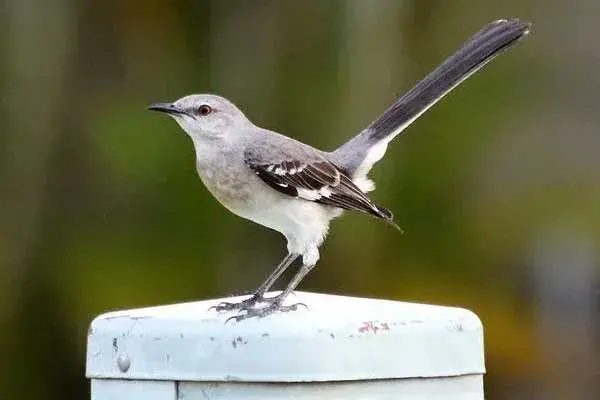
- Scientific name: Mimus polyglottos
Northern mockingbirds are state birds of Texas. They live year-round across the state and can be seen in all sorts of habitats, from desert to forest to city.
The Latin name of these birds translates to “many-tongued mimic,” and for a reason – northern mockingbirds can imitate chirps of up to 35 species and learn over 200 different songs in their lifetime!
They can mimic sounds of rusty hinges, car alarms, cackling hens, and dog barks; they can mimic so well that it’s hard to tell a difference even with an electronic analysis.
Both males and females sing; listen for a long series of musical and grating phrases, each repeated 3 or more times. Male mockingbirds that have no partners will sing more often than mated ones; only the unmated males sing at night.
Northern mockingbirds have four recognized calls: the nest relief call, hew call, chat, and the begging call.
Source: Sandtouch Limited Company, a Texas limited liability company, CC BY 3.0, via Wikimedia Commons
You will easily identify them in person by their gray plumage with whitish underparts and long tails. In case you see one while it’s flying, notice the large white patches on its black wings and tails.
Those white patches help them to show off during the mating season and to flash them when defending territory against some snakes and hawks.
Northern mockingbirds are territorial birds that can be extremely good at breeding – scientists once recorded a female that managed to lay 27 eggs in a single season! Their pale blue or greenish eggs have splotches of reddish-brown concentrated at the larger end.
2. Painted Bunting
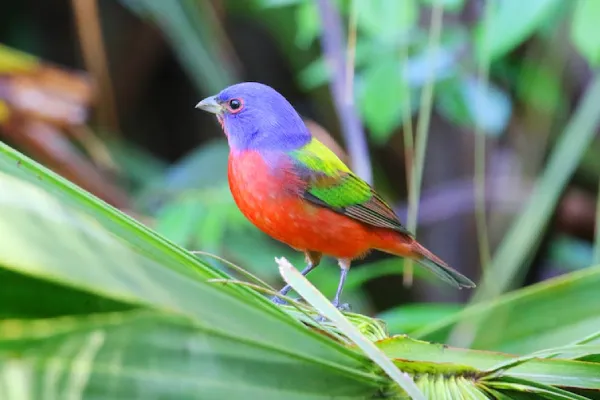
- Scientific name: Passerina ciris
Often referred to as “nonpareil,” or “unrivaled,” painted buntings are one of the most colorful and beautiful birds of Texas and the entire North America.
You will recognize males by their stunning blue head color, red underparts, and green backs. Females usually have bright yellow-green colors.
These stunning blue-headed birds are common summer residents in most of Texas. Look for them around streams, forest edges, and other areas with dense understory.
Although common in the state, you might have trouble finding them there since they like to stay in deep brush. The best time to see and hear them would be early in the morning when the males usually sing.
Painted buntings have a lovely song consisting of short, sweet, high-pitched notes that last around 2 seconds. During springtime, a single male will sing 9-10 songs per minute from different perches in his territory to mark his boundaries.
Painted bunting song
These vibrant birds will also engage in a behavior called “countersinging” with neighboring males, where they take turns singing back and forth to assert their territories. Their call is a soft “plik.”
They might look cute and colorful, but painted buntings are aggressive birds. They are very territorial and will attack other males of their species.
A group of painted buntings is known as a “mural” and a “palette”. Certainly suits their looks!
3. Indigo Bunting
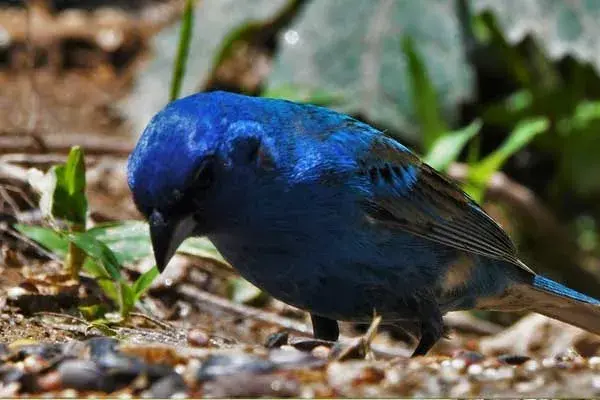
- Scientific name: Passerina cyanea
This small seed-eating bird can be seen in north, central, and eastern Texas during summer. Indigo buntings are common in open woodlands, brushy fields, and parks of the state.
Somewhere around September and November, these birds will leave TX and migrate south, to Mexico, South, and Central America. They will travel during the night and use stars as navigation.
You can identify adult males by their vibrant blue plumage during summer, with slightly richer blue colors on their heads. During the winter months, they become brown. Females are brown year-round.
Their song is a rapid, excited warble with each note or phrase being given twice. When marking their territory or attracting females, males will emit a high-pitched song that lasts 2-4 seconds and sounds like “sweet-sweet chew-chew.” Both sexes will also use a sharp “chip” alarm call.
Source: G. McGrane, Public domain, via Wikimedia Commons
Because of their bright blue color, many people consider indigo buntings to symbolize wisdom and spiritual realization. These birds usually mate for life; occasionally, they may switch partners within a single breeding season.
4. Eastern Kingbird
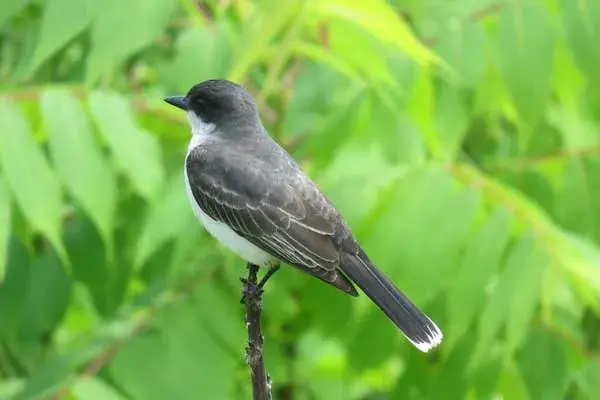
- Scientific name: Tyrannus tyrannus
Eastern kingbirds are common and easy to spot in northern and eastern parts of Texas during summer. You will recognize them by their gray-black upperparts, white underbelly, and pointed wings.
Look for eastern kingbirds around open areas, pasture edges, and parks, and listen for their high-pitched “kit-kit” and “dzee-dzee” calls. They will often perch on wires, watch for large insects, and make quick flights to snatch them.
Source: Jonathon Jongsma, CC BY-SA 3.0, via Wikimedia Commons
During their breeding season, they are very aggressive and territorial and will chase away any bird that enters their territories, including large ones like hawks and crows.
After spending summer here, these Texas songbirds will migrate south to spend winter in South America, primarily northwestern Amazonia.
They are also one of our examples of black and white birds from Colorado.
5. Ruby-crowned Kinglet

- Scientific name: Regulus calendula
Ruby-crowned kinglets are one of the smallest songbirds in Texas that weigh around 0.3 oz and measure just 3.9 in long.
Identify them by their olive-green colors and two white wing bars and white eye-rings. Males also have red crown patches, which are usually concealed.
They can be found across most of Texas in the winter; arriving in the state around September and departing in May. After wintering in the state, they move to breed in northern parts of Canada and the US.
Despite their miniature size, they make very loud and complex sounds. Ruby-crowned kinglets’ song lasts around 5 seconds and has three parts: high-pitched “zee-zee” notes, low “turr” trills, and repeated “tee-da-leet” phrases. Their call is a harsh, fast, two-parted scold.
Source: G. McGrane, Public domain, via Wikimedia Commons
During winter they can be often spotted darting low around parks, woodlands, and brushy areas.
Ruby-crowned kinglets build cup-shaped nests and have the largest clutch of any North American passerine for its size. A female may lay up to 12 eggs and that entire clutch can weigh as much as the female herself!
6. Eastern Bluebird
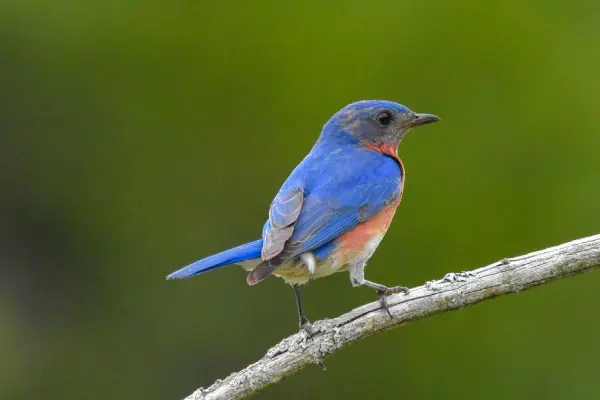
- Scientific name: Sialia sialis
Eastern bluebirds breed in the eastern half of Texas, before moving to the southern end of the state during the winter. These small North American migratory thrushes breed in the state from mid-February to late July.
Marvelous birds to capture in your binoculars, you will recognize them by their big, rounded heads, large eyes, and alert posture. Males have vivid royal blue wings, heads, and back plumage, and warm red-brown and white breasts.
The Eastern bluebird is the most widespread of the three bluebird species and can be found around open woodlands, roadsides, farmlands, and orchards.
To attract a female, a male bluebird will sing over 1,000 songs per hour; it sings without opening its beak wide. Listen for their soft melodious warble song and their liquid and musical “turee” or “queedle” call. They will often sing while perched on a fencepost or power line.
Source: Jonathon Jongsma, CC BY-SA 3.0, via Wikimedia Commons
Eastern bluebirds are cavity nesters that often use nest boxes. In case you want to attract one, try placing your nestbox some 40 yards from a wood edge and away from a seed feeding station. Eastern bluebirds might be also attracted to peanut butter mixes, suet, fruit, raisins soaked in hot water, and mealworms.
7. House Sparrow

- Scientific name: Passer domesticus
House sparrows are small brightly colored birds with gray heads, white cheeks, black bibs, and reddish-brown necks. They were introduced to Texas and can now be seen there throughout the year, in all 254 counties of the state.
Listen for their simple song consisting of a series of “cheep” or “chirrup” notes. When agitated, males will emit trilled “chur-chur-r-r-it-it” calls.
Source: Gypsypkd, Public domain, via Wikimedia Commons
These common backyard songbirds of Texas are also one of the most widely distributed birds in the world.
8. Dark-eyed Junco
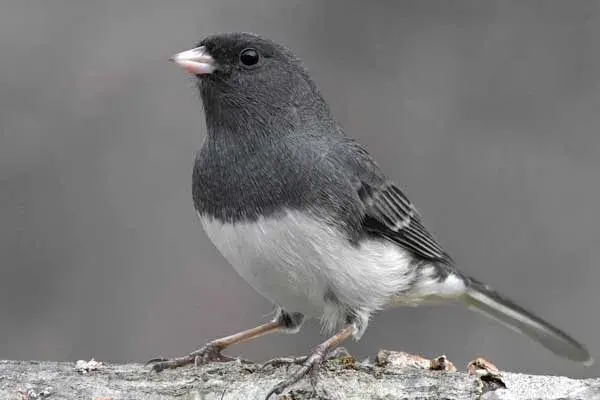
- Scientific name: Junco hyemalis
These medium-sized sparrows with rounded heads, short bills, and fairly long tails are common throughout Texas during winter. Dark-eyed juncos are dark above, white below, and have dark heads, and pale bills.
Typically found around woodlands, brushy fields, parks, and thickets, they are also one of the most common birds in North America. They often forage while hopping and running on the ground and might even scratch the ground/snow with their feet in pursuit of food.
The song of male dark-eyed juncos is a strong musical trill that lasts around 2 seconds and consists of up to 20 notes. Both sexes usually have a quieter song that includes different whistles, trills, and warbles. Their calls include high-pitched “chip” and “tick” sounds.
Source: G. McGrane, Public domain, via Wikimedia Commons
They got nicknamed “snowbirds” because they’re commonly sighted in winter throughout North America.
9. American Goldfinch
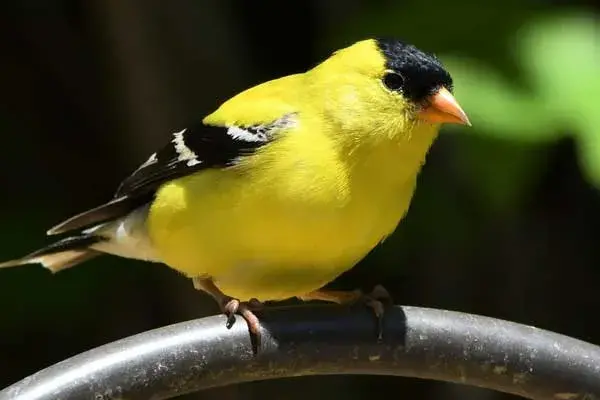
- Scientific name: Spinus tristis
American goldfinches are one of the tiniest finches found in Texas. These migratory birds have small heads, long wings, and short, notched tails.
Common around open woodlands, backyards, and parks during winter, they arrive in the state in the fall (around October) and stay there until May before moving north to breed.
Males are easy to spot by their stunning bumblebee pattern when nesting, orange beaks, black foreheads, and white bars over their black wings. During the winter months, males get an olive color while the females become dull yellow-brown.
American goldfinches can be also identified by their winter calls that sound like “per-chi-cor-ree.”
Source: G McGrane, Public domain, via Wikimedia Commons
Males and females also have colorful carotenoid-based orange bills during the breeding season; the bill serves as an indicator of the overall health of the bird. The more saturated with orange a bill is, the higher the testosterone levels are in that specific bird.
These cute songbirds also love to visit bird feeders, so make sure to sunflower seeds and nyjer seeds to attract them.
10. Common Starling
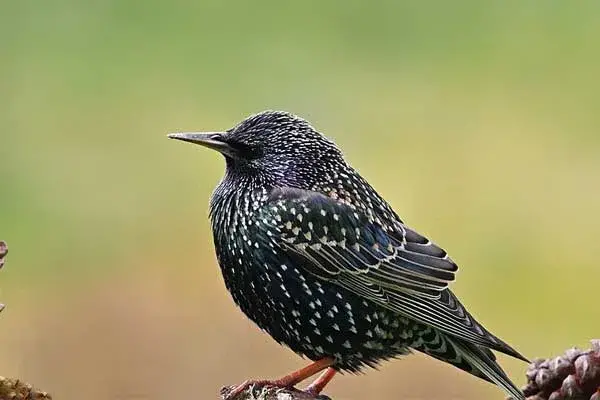
- Scientific name: Sturnus vulgaris
Common starlings, also known as the European starlings, were introduced to North America from Europe at the end of the 19th century; they are now designated as invasive species there.
These medium-sized passerine birds are common around woodlands, parks, backyards, and urban areas of entire Texas. Common starlings can be seen year-round in the state, especially in areas where people live.
These stocky birds have white dots on their dark plumage, short tails, triangular wings, and long, pointed beaks.
Common starlings possess impressive vocal abilities and mimicry skills, producing a wide range of warbles, whistles, chatter, liquid-like notes, harsh trills, and rattles.
Their songs usually consist of either loud whistles or softer, jumbled warbling, with the whistles often used between males and the warbled songs directed towards females. Both male and female starlings will also use around 10 types of calls to communicate.
Common Starling Song | Source: Vladimir Yu. Arkhipov, Arkhivov, CC BY-SA 3.0, via Wikimedia Commons
Very loud and social, they can live in huge flocks; winter roosts can include from a few thousand to several million birds. Look for them perching and roosting high on wires, trees, and buildings.
11. Northern Cardinal

- Scientific name: Cardinalis cardinalis
These popular songbirds can be seen year-round in the eastern two-thirds of Texas. Northern cardinals are common around woodlands, brushy fields, parks, and other urban areas – something Texas has in abundance. They are also familiar sights in many backyards.
Also known as redbirds, they get their red color from the food they eat – if there are not enough carotenoids in their meals, they become brownish.
Both male and female cardinals sing almost year-round. Listen for their 2-3 second song which is a loud string of clear down-slurred or two-parted whistles that sound like “cheer-cheer,” “birdie-birdie,” and “wheet-wheet.”
Source: G. McGrane, Public domain, via Wikimedia Commons
Northern cardinals’ most common call is a loud, metallic chip they use to chase away other males entering their territories.
The species is sexually dimorphic – males and females look different. You will recognize males by their bright red plumage, crests on their heads, and black throats and faces. Females are mostly brown with crests, reddish wings and tails, and without facial masks.
These monogamous birds are very territorial and aggressive – northern cardinals will often try to attack their reflections in the mirrors and windows. To attract northern cardinals to your bird feeder, make sure to add some sunflower seeds, peanut hearts, millet, or milo.
Read More: Unique Red And Black Animals (With Photos)
12. Blue Jay
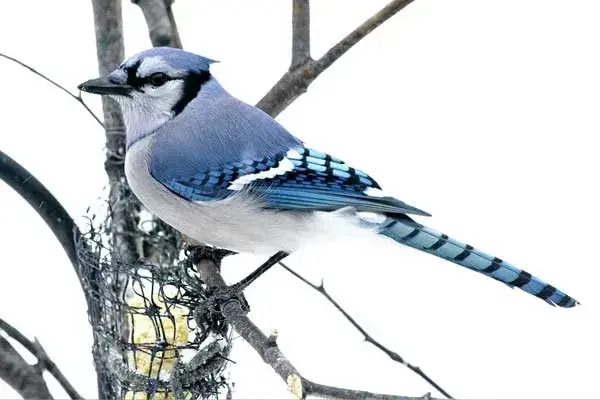
- Scientific name: Cyanocitta cristata
Blue jays are large and nonmigratory songbirds found throughout the eastern half of Texas. They are commonly found in city parks, forests, and woodlands of the state.
These blue and white birds are easy to recognize as males and females look the same. Blue jays are blue above, and gray below, and have crests and black collars. They also have bright blue wings with white spots.
Blue jays will often mimic hawk sounds when approaching a feeding site to drive away other birds. They make a large variety of sounds and may even learn to mimic human speech.
Blue jays’ song is a mixture of clicks, chucks, whirrs, whines, liquid notes, and elements of other calls. Their alarm call is a loud, almost gull-like scream.
Source: G. McGrane, Public domain, via Wikimedia Commons
Despite not being a state bird in any US state, blue jays are the mascot of a Major League Baseball team called the Toronto Blue Jays. These songbirds are highly intelligent and can even use tools.
13. Green Jay
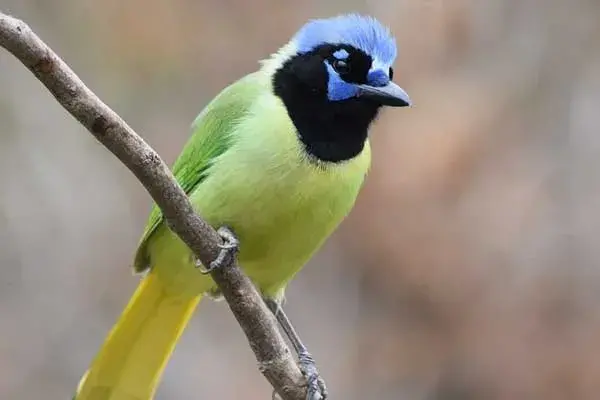
- Scientific name: Cyanocorax yncas
Green jays are colorful and noisy tropical birds found in North, Central, and South America. In the USA, these songbirds can be seen year-round in southern Texas, around woodlands and thorn forests.
Known locally as the Rio Grande jays, these birds can be identified by their green backs, yellow underparts, blue and black heads, and very short and blue eyebrows.
They are very intelligent and will use sticks as tools to get insects from tree bark. Green jays are omnivores that feed on different insects, small vertebrates, seeds, and fruit.
Similar to other birds, like blue jays, green jays in Texas will mimic hawk calls when approaching a feeding site to scare away other birds.
They are also known for their frequent and loud bell-like calls when flying, and they also make regular, loud “cheh” contact calls while foraging in groups. In addition to these, they have a variety of other calls that are used in specific social situations and can sound like screaming, bubbling, rattling, buzzing, peeping, or clicking.
Source: Niels Krabbe, CC BY-SA 4.0, via Wikimedia Commons
These brilliantly-colored birds got their scientific name “yncas” from the word “Inca” because the first descriptions of this species were based on birds from Peru, the place where Inca Empire rose.
14. Barn Swallow
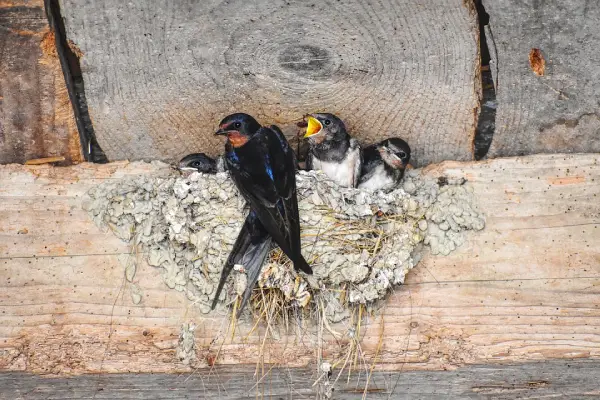
- Scientific name: Hirundo rustica
Barn swallows are the most widespread species of swallow in the world. They move from their North American breeding ground around early fall and migrate to Central and South America for the winter.
If you live anywhere in Texas, look for barn swallows during the summer months. They are common in open areas, parks, and fields.
Barn swallows will often nest on the eaves of buildings and can be easily identified by their forked tails, dark blue upperparts, rusty throats, cinnamon-colored bellies, and squeaky songs.
Barn swallows have a “twitter-warble” song during the breeding season that consists of a long series of continuous warbling sounds and rapid, mechanical-sounding “whirrs.”
Source: Record by Justin Wasack as stated on this site: http://www.freesound.org/samplesViewSingle.php?id=74868, CC BY 3.0, via Wikimedia Commons
These birds build open-cup nests using mud and dried grass. They used to nest around caves and rocky crevices, but today, they mainly use man-made structures that have overhanging eaves or flat surfaces.
According to the legend, barn swallows stole fire from the gods and gave it to people. Gods became so angry that they threw a firebrand at the bird, burning its middle tail feathers.
15. American Robin

- Scientific name: Turdus migratorius
These migratory songbirds are a common sight on lawns, backyards, and open woodlands throughout Texas year-round. In case you live in San Antonio, visit Brackenridge Park as American robin has been nesting there in recent years.
Males are easy to identify by their black heads, yellow beaks with gray tips, and brick-red breasts. Females are slightly duller and have brown heads. Look for large flocks of birds, sometimes up to 10,000 individuals.
Their song is described as a “cheery” carol consisting of a string of 10 or so clear whistles; American robins also have a sharp “yeep” alarm call or a mumbled “tuk” when communicating with one another.
Source: G. McGrane, Public domain, via Wikimedia Commons
American robins are the state birds of Connecticut, Michigan, and Wisconsin. They are omnivores with a sweet tooth and will feast on fruits, berries, and even cakes and pastries.
American robins nest in the state from March through June and produce 2-3 broods per year with 3-4 young per clutch.
16. Cedar Waxwing

- Scientific name: Bombycilla cedrorum
Texas’s winter residents, these medium-sized sleek birds have large heads with a crest, a black facial mask, and short necks and bills. Cedar waxwings got their names from the waxy red tips on their secondary wing feathers.
They are classified as songbirds but have no song. Instead, they use several short and simple calls, a high-pitched “bzee” and a sighing whistle.
Source: Jonathon Jongsma, CC BY-SA 3.0, via Wikimedia Commons
Common in different habitats that include woodlands, backyards, and parks, they are one of the few North American birds that can survive eating only fruit for several months. If the birds eat enough of the honeysuckle fruit while growing up, the tips of their tails will turn from yellow to orange.
Cedar waxwings will also lay a clutch of bluish-gray eggs with brown and black spots.
17. Spotted Towhee
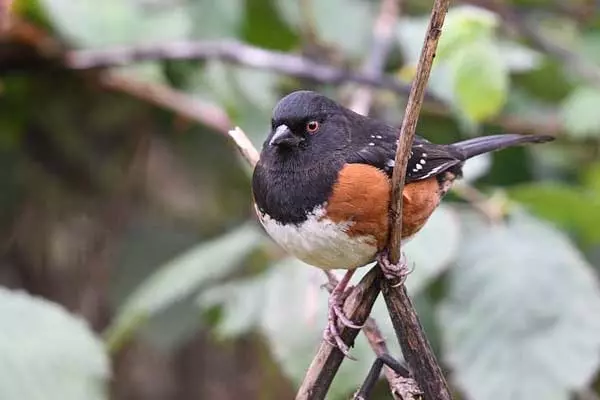
- Scientific name: Pipilo maculatus
These large, striking, and long-tailed sparrows can be seen in most of Texas from early October until late May.
Recognize spotted towhees by their black hoods, black backs, and black wings that are speckled with white spots, white bellies and tail tips, and rufous flanks. Females are similar to males but are dark brown and gray instead of black.
Spotted towhees have a fairly simple song. It lasts for about 1.5 seconds and begins with a few short introductory notes followed by a fast trill that resembles the plucking of a taut rubber band or the sound of paper being caught in a fan. When it comes to their calls, Spotted towhees emit a mewing call reminiscent of a cat’s sound, lasting a little over half a second.
Source: Jonathon Jongsma, CC BY-SA 3.0, via Wikimedia Commons
Look for them around woodlands, brushy fields, and forest edges, nesting on the ground or low in bushes. They are also common around bird feeders so you might be lucky to find a spotted towhee around your backyard.
18. Purple Martin
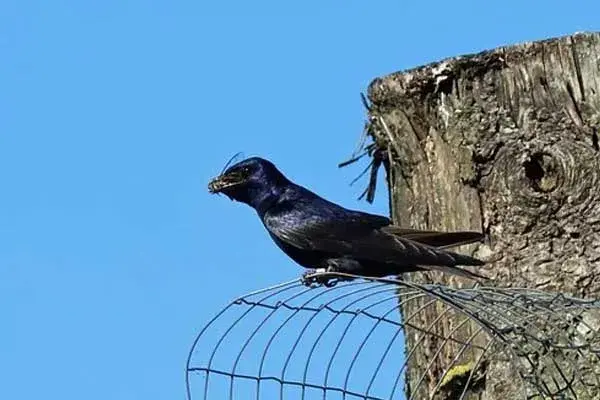
- Scientific name: Progne subis
Purple martins are the largest swallows in North America, famous for their chattering song and aerial acrobatics. They are breeding residents of the eastern two-thirds of Texas.
These migratory songbirds winter in the rainforests of Brazil and then undertake a 7,000-mile-long migration trip back into the eastern United States and Canada.
The first purple martins of the year can be spotted in Texas around mid-March; you will see males that usually arrive before the females. They will scout for new or unoccupied martin houses but the females are the ones that make the final decision.
Pairs typically build their nests out of straw, twigs, and pine needles. They are easy to identify too; just look for birds with slightly hooked beaks, short and forked tails, and long, tapered wings. Males have glossy purple-blue plumage while females are gray to mottled purple.
Purple martins are very vocal birds. Their most common songs are chirps, chortles, rattles, and croaks. When fighting over territory, purple martins will make a “hee-hee” sound and a “zwrack” call when interacting with other species.
Source: Jonathon Jongsma, CC BY-SA 3.0, via Wikimedia Commons
They are very social and colonial birds – the largest roosting colony ever discovered had over 700,000 birds! Purple martins are carnivores that use the hawking strategy to catch insects – they will swoop down and catch them mid-flight.
19. Common Grackle
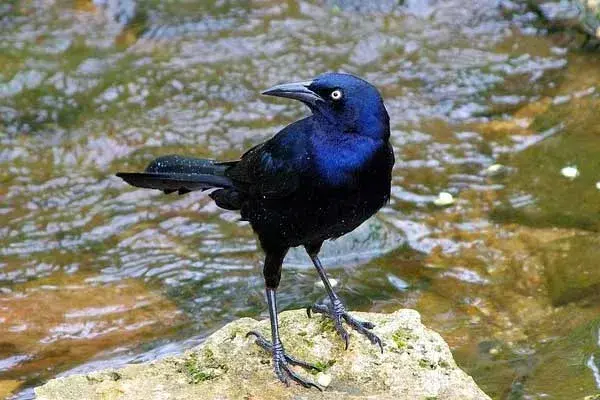
- Scientific name: Quiscalus quiscula
Common grackles are one of the most widespread black birds with blue heads. They are found throughout most of North America east of the Rocky Mountains and they inhabit woods, fields, farms, and urban areas.
Identify common grackles by their long, keel-shaped tails, dark beaks, and yellow eyes. Males have glossy black plumage with a blue-green sheen on their heads; females are less iridescent and are mostly brown.
Common grackles are found in the eastern two-thirds of Texas, west through the High Plains and the central Edwards Plateau, and south to the Guadalupe River drainage.
They are permanent residents in eastern parts of the state and can be seen there year-round; some populations will spend winter in the eastern third of the state, typically from the middle of September until the end of March.
When the winter comes, common grackles will gather in flocks including millions of birds, often with other blackbird species.
These medium-sized backyard birds are classified as songbirds because they have all the vocal equipment of a songbird, not because they have beautiful songs.
Their song is a high-pitched rising “readle-eak” screech that sounds like a rusty gate opening. Some popular Texas dailies describe grackles’ songs as sounding like “everything from a squeaky door hinge and explosions of static from a radio left on at high volume to laughing whistles to monkey-like rattles.”
Source: Jonathon Jongsma, CC BY-SA 3.0, via Wikimedia Commons
They can also mimic the sounds of other birds or even humans, although not as well as northern mockingbirds can, for example.
Common grackles breed in Texas from March to July, build their nests using twigs, leaves, and grasses, and place them high up in conifer trees near water.
Read More: All grackle species that live in Texas
20. Summer Tanager
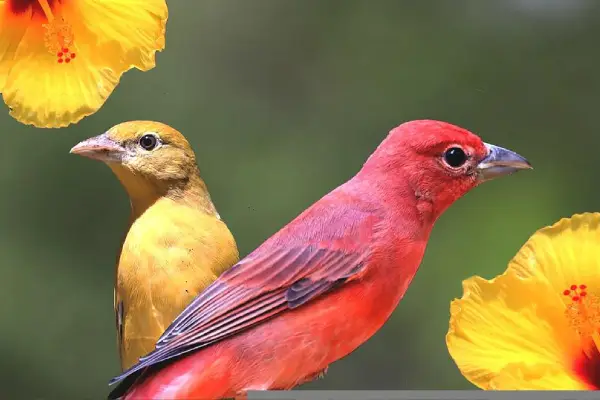
- Scientific name: Piranga rubra
Summer tanagers are medium-sized American songbirds that have big bodies, large heads, and thick blunt-tipped beaks. Males are bright all-red with heavy beaks and dark legs while females are olive above and yellowish below.
Texans sometimes describe them as “cardinals without a crest.” These birds leave the state in the fall and move to their tropical wintering grounds in central and northern South America. They are back around April, announcing themselves with distinctive sounds.
Listen for a series of robin-like musical phrases; their calls are sharp “pik-i-tuk-i-tuk”.
Source: G. McGrane, Public domain, via Wikimedia Commons
Despite having one of the most striking colors in the state, summer tanagers might be hard to spot as they prefer to forage high in the tree canopy. Look for them around open woodlands and parks.
These beautiful birds will have a clutch of 3-4 pale green to pale blue eggs with brown markings. Females will incubate the eggs while the males feed them. Both partners will take care of the chicks.
21. Lesser Goldfinch
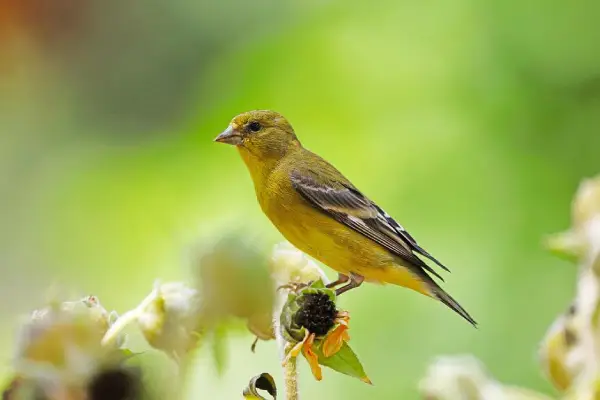
- Scientific name: Spinus psaltria
Lesser goldfinches are the smallest true finches in Texas and the entire North America. These songbirds are distinctly smaller than American goldfinches and have long, pointed wings, and short, notched tails.
Male lesser goldfinches are bright yellow below and green or black on their backs. They also have black crowns and white patches on their wings. Females are olive-green below, dull yellow under, and have black wings with two whitish wing bars.
Lesser goldfinches can be seen throughout the year in southern, central, and western parts of Texas. They breed in the state from March to July and are common in the open brushy country, open woods, wooded streams, parks, and gardens
The song of lesser goldfinches consists of a series of melodious notes and trills; listen for their descending squeaky whistles and harsh “chig chig” calls emitted during flight.
Lesser goldfinch song
Lesser goldfinches are social birds that might mix with other songbirds, especially around bird feeders, creating groups of several hundred individuals. They are herbivores that feed on seeds and grains.
22. Eastern Meadowlark
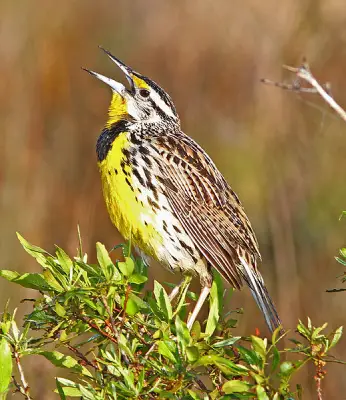
- Scientific name: Sturnella magna
Despite what the name might suggest, eastern meadowlarks are not larks but blackbirds. These medium-sized birds that look similar to related western meadowlarks are common in the eastern half of Texas.
You will find them around pastures, brushy fields, and grasslands. They love to perch on fence wires. Look for birds with yellow throats and breasts, a black collar, and streaked brown upperparts.
These songbirds with short tails and long, spear-shaped bills, are also vocal. They have a repertoire of songs, switching between different versions after singing one repeatedly for a while.
The male’s song is a beautiful combination of 3 to 5 (sometimes up to 8) pure and plaintive flutelike whistles, slurred together and gradually dropping in pitch, lasting up to 2 seconds. When it comes to their calls, eastern meadowlarks will emit a sharp “dzert” note to signal intrusion, a 1.5-second harsh chatter produced by both males and females, and a series of “weet” calls while in flight.
Source: G. McGrane, Public domain, via Wikimedia Commons
Eastern meadowlarks build their nests on the ground, well-hidden by the dense vegetation of grasslands they live in, and lay 2-7 white eggs with brown spots and speckles once or twice a year.
23. Red-winged Blackbird
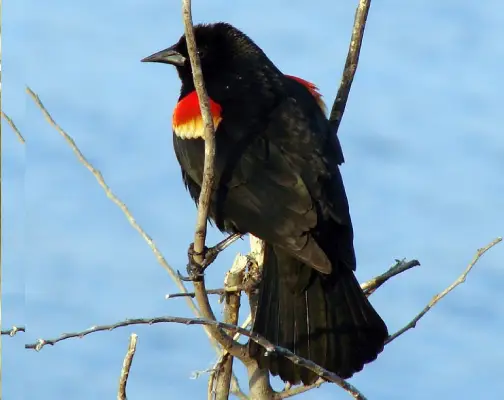
- Scientific name: Agelaius phoeniceus
Red-winged blackbirds are common Texas songbirds found year-round in the state. Common around all types of open habitats, roadsides, wet meadows, and cattail marshes, their scientific name “agelaios” means “gregarious,” while the “phoeniceus” means “crimson” or “red,” which perfectly describes these birds.
Males can be identified by their black plumage with red epaulets that are edged in yellow. They often perch on fences, wires, and the tops of shrubs and sing their raucous “conk-a-ree-onk” songs.
Source: G. McGrane, Public domain, via Wikimedia Commons
The singing is frequently accompanied by the flashing of their brilliant epaulets.
Red-winged blackbirds are also gregarious, very territorial, and polygynous birds, where one male can have up to 10 different females making nests in his territory. Females, on the other hand, will frequently mate with other males, and often lay clutches of mixed paternity.
24. Couch’s Kingbird

- Scientific name: Tyrannus couchii
Couch’s kingbird is a large flycatcher that can be found around woodland edges and near ponds and rivers in southern Texas during the summer.
This yellow-breasted bird has a pale gray head, whitish throat, and gray-brown upperparts. It also has a dark beak, legs, and a slightly forked tail.
Couch’s kingbird got its name after the soldier and naturalist Darius N. Couch. It looks very similar to a tropical kingbird and until the 1960s the two were considered to be the same species.
Males produce a distinctive song consisting of burry “peer” notes, accompanied by querulous notes or sharp pits. Nesting birds mostly sing these songs, particularly at the end of the day and before dawn. Both sexes also have a quick “kip” and a harsh, grating “chi-queeer” call.
Couch’s kingbird song
Couch’s kingbird is an omnivore that feeds on small berries, seeds, and larger insects like beetles, grasshoppers, wasps, and large flies.
25. House Finch

- Scientific name: Haemorhous mexicanus
House finches are widespread small songbirds that have conical bills, short wings, and shallowly notched tails. Males can be identified by their streaky pink-red breasts, eyebrows, foreheads, and rumps, while females are brown above and streaked below; they have no red color.
House finches can be seen year-round in Texas, they are permanent residents throughout the western half of the state.
The song of house finch males is a long, jumbled warbling that consists of short notes. Their call is a sharp “cheep.”
Source: Jonathon Jongsma, CC BY-SA 3.0, via Wikimedia Commons
Depending on the location, house finches have different “accents” while singing; their songs will have different lengths with more or fewer syllables.
They are gregarious and loud birds; look for them around city parks, urban centers, residential backyards, farms, and forest edges in large flocks. During the non-breeding season, you might also see flocks of house finches around bird feeders.
If you want to attract house finches to your backyard, make sure to add black oil sunflower seeds, millet, and milo.
The pink-red color of the males comes from the berries and fruits in their diet – females prefer to mate with males that have the brightest faces.
House finches are also one of many birds that live in the Northeastern USA.
Summary
This concludes our list of songbirds of Texas. There are plenty of these in the state, from house finches, northern mockingbirds, and summer tanagers to American robins and eastern kingbirds.
Next time you see or hear any of these birds in person, you should be able to recognize them with ease!
And if you enjoyed our article, explore our other popular reads on North American songbirds: